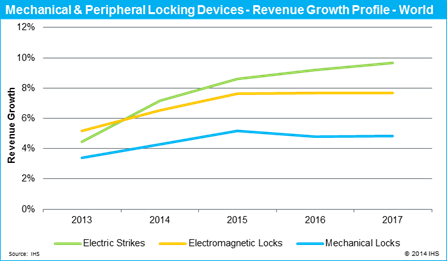Impact of Access Control on Mechanical Locking Devices
The increased popularity of electronic access control systems is contributing to the market growth of electric strikes and electromagnetic locks, each of which is forecast to outpe...

The increased popularity of electronic access control systems is contributing to the market growth of electric strikes and electromagnetic locks, each of which is forecast to outperform mechanical locks through 2017. IHS expects from 2012 to 2017, global revenues for electromagnetic locks and electric strikes will grow at compound annual growth rates (CAGRs) of 6.9% and 7.8% respectively. In comparison, mechanical locks are projected to experience a weaker CAGR of 4.5% in the same time frame.
Access control systems are becoming increasingly popular because they provide a higher level of security while offering integration opportunities with time management and building automation systems. While the main barrier for growth of electronic access control is higher upfront cost, the long term benefits involve reduction in costs associated with rekeying mechanical cylinders.
Although the trend towards access control solutions is driving the uptake of electric locking devices, they are not completely replacing mechanical locks. IHS expects most applications still require a mechanical lock override in the case of a power failure or system error thus access control is only limiting the growth of mechanical solutions in the medium-term, not necessarily replacing them.
In terms of electric lock uptake, electromagnetic locks and electric strikes are the most common electric locking devices used in accordance with access control systems. Traditionally, electromagnetic locks have been the standard solution; however mature markets such as the United States and Western Europe have started adopting electric strikes at a stronger pace. Electric strikes are assumed to be more secure, aesthetically-pleasing, and more energy efficient than electromagnetic locks and are projected to have stronger growth from 2012 to 2017 in every region except Asia. This is due to the Chinese market's preference to use electromagnetic locks over electric strikes. Electromagnetic locks are easier to manufacture, more affordable, and simpler to install making them ideal for more price competitive markets such as China.
This trend towards electric locking solutions is not only impacting mechanical locks, but exit devices as well. Globally, standard mechanical exit devices were estimated by IHS to account for 70.8% of all exit device revenues in 2012. This number is projected to decline to 69.8% by 2017 due to the increased adoption of electrified trim and electrified latch retraction exit devices. Solutions that implement electric locking devices as a means of security will commonly install electric exit devices for egress in order to fulfill a complete access control system.
Overall, the trend towards electric locking solutions is active on a global level. While growth for mechanical locks is expected to be somewhat limited due to this trend, the global mechanical locks market is still projected to have healthy growth in the medium-term. In terms of revenue, when comparing the markets for exit devices, mechanical locks and electric locks (strikes and electromagnetic), IHS estimates that about 77% were mechanical in 2012. By 2017, IHS expects the market for mechanical solutions to represent only 71%.














